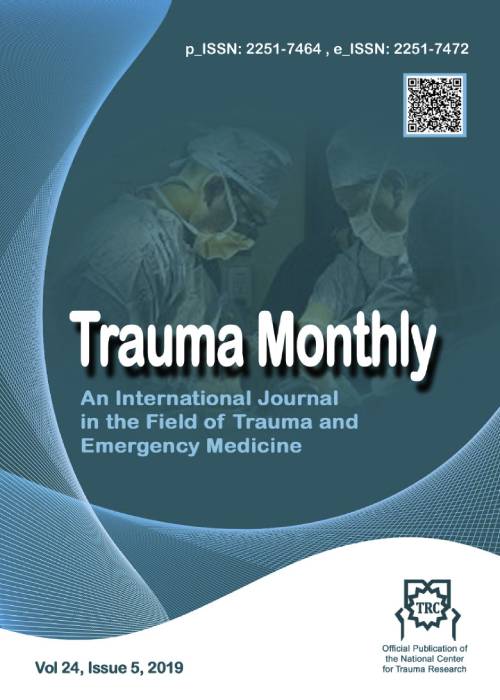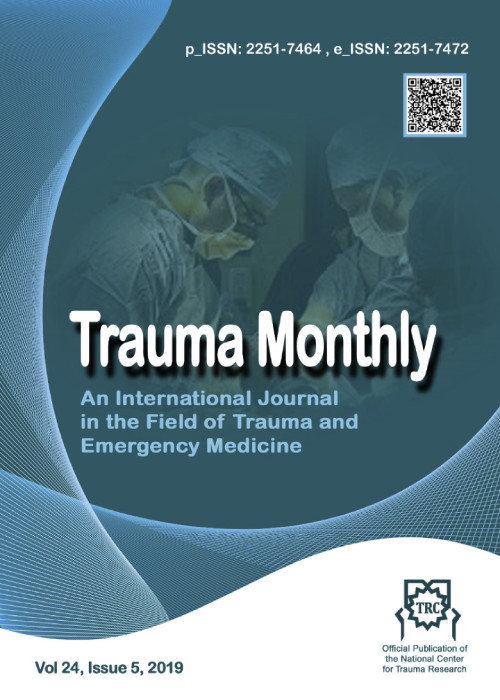فهرست مطالب

Trauma Monthly
Volume:28 Issue: 5, Sep-Oct 2023
- تاریخ انتشار: 1402/09/11
- تعداد عناوین: 8
-
-
Pages 901-906IntroductionPreterm neonates are at high risk for a wide range of diseases and serious complications, namely intracranial hemorrhage (ICH).MethodThis cross-sectional study included 120 infants (60 preterm infants with intracranial hemorrhage and 60 healthy preterm infants) under 37 weeks old. In the first 3-4 days after birth, color Doppler of the neonatal middle cerebral artery was performed. Then, serial Doppler ultrasound was performed weekly (first four weeks after delivery) for one month and was compared between the two groups.ResultsIn this study, among the Doppler parameters in the first week after birth, none of the parameters AT, S/D, PI, RI, and PSV were statistically significant between the two groups of preterm infants with ICH and normal preterm infants (P>0.05).ConclusionsNone of the Doppler parameters AT, S/D, PI, RI, and PSV were statistically significant between the two groups of preterm infants with intracranial hemorrhage and normal preterm infants.Keywords: Preterm infants, Intracranial hemorrhage, middle cerebral artery, Brain Complications
-
Pages 907-913IntroductionPopliteal artery injuries (PAIs) are among the most severe peripheral vascular injuries; they may lead to movement impairment or amputation. This study aimed to compare the repair results of PAIs following blunt and penetrating trauma in patients referred to our Vascular Surgery Center in southwest Iran.MethodsIn this cross-sectional study, 92 patients with vascular trauma referred to the Southwest Trauma Center of Iran in 2020 were assessed. The sampling method was census. The data collection tool was a checklist containing demographic information, medical information, vascular information, Functional Independence Measure (FIM) Score, Mangled Extremity Severity Score (MESS), and Injury Severity Score (ISS). The chi-square test, Fisher exact test, and independent t-test were used to compare categorical and quantitative data between case and control groups. Statistical analyses were conducted using SPSS version 24. The significance level considered was a p-value less than 0.05.ResultsIn this study of 92 participants, 63.1% (58) had blunt trauma injuries (case group). The mean age of participants in the case group was 45.37 ± 9.14, and in the control group was 49.43 ± 10.65. The mean GCS of participants in the case group was 10.80 ± 1.30, and in the control group, it was 11.72 ± 0.70, and 10.6% of participants needed limb fasciotomy (1.7% in the case group and 26.3% in the control group). The amputation rate was 12% in the case group and 8.8% in the control group. There was a significant difference between the two groups in terms of organ fasciotomy (P = 0.035), type of PAI (P = 0.018), and fracture (P = 0.007). MESS (P < 0.001), FIM Score (P < 0.001), ISS (P = 0.044), time of discharge (P < 0.001), and arterial condition (P < 0.001).ConclusionsThe results showed that the complications of penetrating PAI (organ fasciotomy, type of fracture, ISS, MESS, FIM score, time of discharge, and arterial condition were significantly more than in blunt injuries.Keywords: Blunt Trauma, Penetrating Trauma, Popliteal Artery, Vascular Surgery
-
Pages 914-921IntroductionDetermining the factors associated with treatment outcomes of patients with acute subdural hematoma is critical in clinical practice. This study evaluated factors related to poor outcomes in elderly patients with acute subdural hematoma following head trauma.MethodsThis cross-sectional study was conducted on 107 elderly patients with acute subdural hematoma treated at the Department of Neuro-Spine Surgery at Thai Binh General Hospital from July 2021 to August 2022. Multivariate analysis was performed to identify factors associated with poor treatment outcomes.ResultsThirty-two out of 107 patients (21.5%) had poor outcomes after treatment. No statistically significant differences were found between age, gender, cause of injury, chronic diseases, Glasgow scale score upon admission, hematoma size, midline deviation, and combined injuries on computed tomography. Only impaired consciousness (GCS) was independently associated with poor outcomes in elderly patients with acute traumatic subdural hematomas.ConclusionThe independent factor associated with poor outcomes in elderly patients with traumatic subdural hematoma is the poor level of consciousness upon admission.Keywords: Acute Subdural Hematoma, Elderly, Intracranial Hematoma, Traumatic Brain Injury
-
Pages 922-926
As knowledge regarding trauma has evolved, debates around language have also emerged among healthcare professionals. These debates include the meaning of terms such as victim and survivor. As a result, professionals across the medical and behavioral healthcare fields must attend to the language of trauma and the unique ways in which individuals express their traumatic experiences. In this article, we provide a perspective on how Substance Abuse and Mental Health Services Administration’s (SAMHSA) trauma-informed care (TIC) principles (i.e., safety, trust, choices, collaboration, and empowerment) can be implemented as an approach to the language of trauma used by healthcare providers. We discuss the nuances of trauma-informed language and consider the influence of sociocultural factors, diversity, and neurodiversity.
Keywords: Trauma Recovery, Trauma-Informed Care, Trauma-Informed Principles, Survivor Language, Victim Language -
Pages 927-934Introduction
This study assessed the effect of four doses of N-acetylcysteine %20 and probiotics on the variety of the oropharyngeal microbial flora of intubated ICU patients.
MethodsIn this study, 60 ICU patients under mechanical ventilation were randomly assigned to three groups and treated with N-acetylcysteine %20 mouth rinse, probiotic, or routine care (chlorhexidine). A culture sample was obtained from the oropharyngeal zone before and 24 hours after mouth rinse.
ResultsThe colonized bacterial count of the sample was not significantly different before intervention among the N-acetylcysteine, probiotic, and routine care groups (P>0.05).
ConclusionThe probiotics and N-acetylcysteine increased the variety of bacterial groups in the oropharyngeal zone. These florae can compete for nutritional items and growth conditions with pathogenic bacteria.
Keywords: N-acetylcysteine, Probiotic, Oropharyngeal Microbial Flora -
Pages 935-942IntroductionTraditional medicine may play an essential role in wound healing. This study aimed to assess the effect of a natural ointment on wound healing in the first stage of an open wound.MethodsThis randomized clinical trial study included 80 patients with pilonidal sinus referred to our hospital in Tehran from 2020 to 2021 who underwent open surgery. Patients were divided into two groups receiving medication and the control group using the block randomization method. Chi-square was used to describe qualitative variables, and T-test was used to describe quantitative variables. Parametric and non-parametric tests were used according to the type of variable distribution. It was used to compare the means of each group. A P-value less than 0.05 was considered significant.ResultsWound healing time, pain intensity, need for analgesic compounds, and wound secretion were significantly shorter in the study group than in the control group (P <0.001).ConclusionThe effect of this natural ointment on wound healing appears promising. Further studies are recommended.Keywords: wound healing, Open Wound, Pilonidal Sinus
-
Pages 943-944
On October 2023, the unprecedented bombing of hospitals by the Israeli army killed more than 10000 victims in Gaza and injured more than 28000. By preventing the entry of medicine, medical supplies, and equipment, the Israeli regime has destroyed the health care system in the Gaza Strip. According to reports of the United Nations and the Red Cross, there is no way to provide relief and even primary health care to the injured. There focus is on targeting civilians and residential areas therefore the number of wounded and victims increase to such an extent that it is beyond the capacity of the health and treatment complexes. The report of the Gaza Ministry of Health indicates that in the recent attacks, most of the dead and wounded are civilians, especially women, and children. The recent invasions of clinics and hospitals is hoped to mobilize the humanitarian and medical societies to stand in solidarity and rescue civilians casualties in the face of these escalating invasions.
Keywords: Gaza Strip, Hospitals, Clinics, Emergency Aid -
Pages 945-946
Fighting and forced displacement are related to disability, mortality, and mental health illnesses. The current war in the Gaze Strip has resulted in children and adolescents leaving their academies and forced displacements into bomb shelters, parking bunches, and refugee structures. The trauma fears that Gaze children are facing possibly put enormous pressure on their physical and mental health, which may be borne throughout their lives. The slaughter of thousands of children is a comprehensive inhumanity. The sense of humanity in a battleground is to help relieve sorrow in the Gaza Strip, save lives and health, and provide consideration for human beings. All human activists hope for emergency aid to healthcare systems in the Gaza Strip. We call upon the UNICEF, WHO, and International Committee of the Red Cross to strengthen its struggles to accomplish humanitarian hospital visits, deliver medical help, and ensure contact with healthcare workers. We hope the entire international medical community will stand with hospitals in the Gaza Strip and criticize this invasion. Gaze, currently sorrowed from fighting, needs agencies with specialists, budgets, and supplies to equip them with necessities, social support, and suitable screening. Also, developing rehabilitation schedules with admiringly educated specialists is necessary to supply the children with adequate coping strategies. Also, the media should recreate an intensive function in the battle period in generating schedules that support children adjusting to routine lives.
Keywords: war, forced displacement, Healthcare, Gaza Strip


